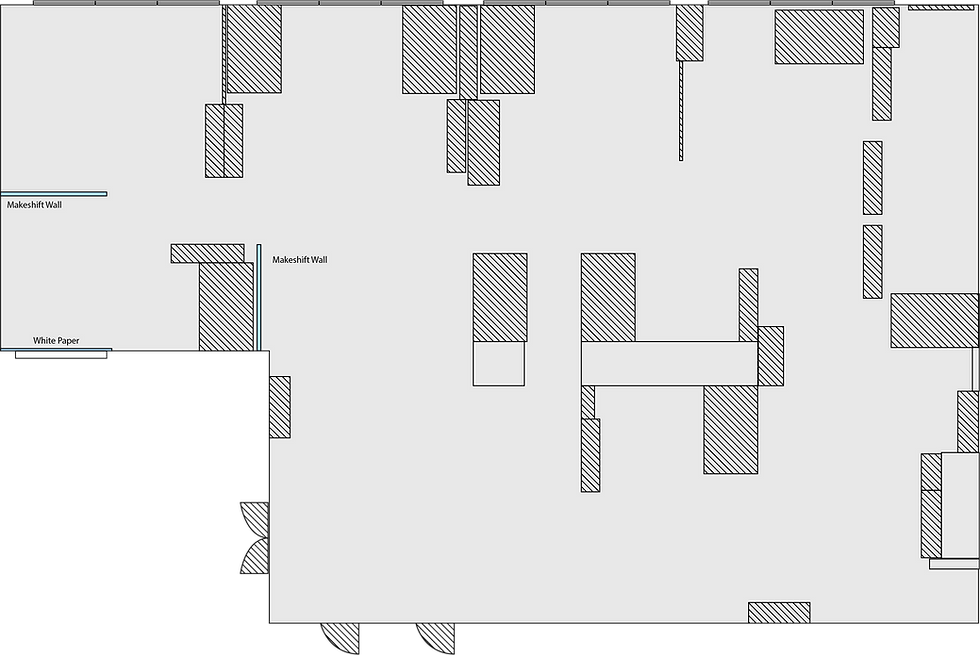Plexus
- Tan Sher Lynn

- Oct 10, 2019
- 3 min read
Updated: Oct 19, 2019
Plexus
Taking inspiration from Jun Hao Ong's Star, I tried redefining the space by connecting the space between objects and furniture.
Model: Monica Clare Mills
Photographer: Me
As Monica walked into the center of the geometrical structure, it began falling apart. Instead, we had her wrapped in the LED strips which got more tangled as she moves in it. That idea came about when we realized that she was painting with fluorescent paint and her paint stained clothes glowed under the LED lights.
Air
I was given a little task by Isabella — make something with air, something that is not quite visible nor tangible. I started collecting and filling plastic gloves with air as a literal response to air being intangible.
I visited Prague City Gallery's recent exhibition on the audio experimentation in visual arts as suggested by Monica as the plastic gloves I was playing around with reminded her of an installation. Robert Vlasák's Speech resembles speech bubbles that inflates when the speaker its connected to "speaks".
Below is the link to the exhibition documentation:
Augmented Reality
Visiting artist, Vítek Škop shared his experience as a freshly graduated designer and the importance of technology in the future of design. Škop began working with augmented reality when developing his recent project Vivid Book which brings physic text books to life with augmented reality.
Škop mentioned Michael Bruce Sterling, an American science fiction author who "prophesized" technologies such as augmented reality. When his imagination came to life, Sterling became involved in the industry. "Augmented Reality" is metaphysical, Sterling stated that its part of the argument about "is computation Artificial Intelligence?" or "is the simulation in the machine a "real" place?". The invasion of virtual realm into the physical "real" world elevates the experience, it is simply fascinating for him to watch what was a lab curiosity until few years ago become what it is today.
What AR means for artistic practice? Škop assert the importance of technology in future of design, and that as the next generation of artist, he believe that boundaries are to be transcended and the possibilities of implementing these technology in design is up to experimentation. On the other hand, being acquainted with some electronic artists and having seen some augmented reality installations, Sterling thought that people in the AR art space are "looking for guidance and trying to find fellow spirits" , in their own way, they have the same pioneer spirit as the business people.
ArtFinder Co-founder Chris Thorpe claimed that the emphasis on art history and institutes has taken away the visceral, emotional experience of art and that experience and excitement should make the audience want to further engage of art. Technology like augmented reality has indeed provided new means for artists to better express themselves, but we should also not forget to reflect on the medium that best connects with the concept and not just using technology for technology sake.
Reference:
Bonasio, A. (2018) 'Augmented Reality Will Reinvent How We Experience Art', Forbes, June 20. Available at: https://www.forbes.com/sites/alicebonasio/2018/06/20/augmented-reality-will-reinvent-how-we-experience-art/#650e652c636c (Accessed : 11 October 2019)
Holmes, K. (2011) 'Talking To The Future Humans - Bruce Sterling', VICE, September 21. Available at: https://www.vice.com/sv/article/ex777e/talking-to-the-future-humans-bruce-sterling-technology-augmented-reality-hacktivism (Accessed : 11 October 2019)
Shute, T. (2010) 'Interview with Bruce Sterling, Part I: At the 9am of the Augmented Reality Industry, are2010', Ugo Trade, Augmented Realities in "World 2.0", June 26. Available at: http://www.ugotrade.com/2010/06/16/interview-with-bruce-sterling-part-i-at-the-9am-of-the-augmented-reality-industry-are2010/ (Accessed : 11 October 2019)
Entropy
This week I read two articles from conceptual artist Robert Smithson's collection, A Tour of the Monuments of Passaic, New Jersey and A Cinematic Atopia, both of which displayed his fascination with entropy.
Smithson observed the transformation of his birthplace, Passaic through the "monuments" of the banal modern landscape. Smithson demonstrated the failure of modern aesthetic and societal achievements, describing the irreversible change as entropy.
‘After the “structural film” there is the sprawl of entropy’. Cinema is tradionally viewed as a medium of preservation and repetition, yet Smithson believes that repetition wears it down stating that cinema fall into obsolescence as soon as it is consumed, eventually becoming waste of the mind.
References:
Burrington, I and Harlan, C. (2011) 'Passaic Eternal', Available at: http://lifewinning.com/projects/passaic-eternal/passaiceternal.pdf (Accessed : 10 October 2019)
Culture Trip. (2016) 'Robert Smithson's Homage to Passaic New Jersey', December 23. Available at: https://theculturetrip.com/north-america/usa/new-jersey/articles/robert-smithson-s-homage-to-passaic-new-jersey/ (Accessed : 10 October 2019)
Mcmullen, S. (2009) 'A Tour of the Monuments of Passaic', School of Visual and Performing Arts, Purdue University, September 12. Available at: https://web.ics.purdue.edu/~smcmulle/AD590E/?p=374 (Accessed : 10 October 2019)
Nardelli, M. (2013) '‘The Sprawl of Entropy’: Cinema, waste, and obsolescence in the 1960s and 1970s', NESCUS, November 8. Available at: https://necsus-ejms.org/the-sprawl-of-entropy-cinema-waste-and-obsolescence-in-the-1960s-and-1970s/ (Accessed : 10 October 2019)






























Comments